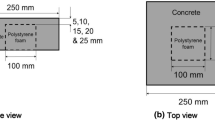Abstract
The active thermography technique is one of the most effective nondestructive tests for evaluating subsurface delaminations in concrete structures. The limitation of this method, which has been studied for some time, is that the width of the smallest detectable defect should be at least two times larger than its depth. However, controversy on this matter remains for concrete material with largely uncertain homogeneity, although the development of the infrared (IR) detector technology improved the above-mentioned limitation. In this study, the pulsed thermography (PT) technique is therefore conducted in the laboratory to investigate the detectability of delaminations with the width-to-depth ratio (w2d) ranging from 1.0 to 7.9 by using a long IR wavelength detector with a focal plane array of 640 \(\times \) 480 pixels. The study focuses on the w2d ratio lower than 2.0. A concrete specimen was made with 12 embedded simulated delaminations having different sizes and depths. The results showed that a combination of PT and pulsed phase thermography can be used to detect delaminations with a w2d ratio equal or greater than 1.25. In addition, the absolute contrast above the delamination increases with the higher w2d ratio, indicating that even for a relatively deep delamination, it is still detectable if a delamination is provided by appropriate heat energy and its size is sufficiently large. Finally, the study also indicates that as the amount of heating energy provided is increased, the greater accuracy in predicting the depth can be obtained.













Similar content being viewed by others
References
Portland Cement Association: Types and Causes of Concrete Deterioration. Portland Cement Association, Skokie (2002)
Ahlborn, T.M., Brooks, C.N.: Evaluation of bridge decks using Non-destructive Evaluation at near Highway Speeds for effective asset management. Michigan Tech., MDOT (2015)
ACI 318-05: Building Code Requirements for Structural Concrete, American Concrete Institute, Farmington Hills (2005)
AASHTO: AASHTO LRFD Bridge Design Specifications, 4th edn. American Association of State Highway and Transportation Officials, Washington (2007)
Vaghefi, K.: Infrared Thermography Enhancements for Concrete Bridge Evaluation. Michigan Technological Univesity, Houghton (2013)
Huh, J., Tran, Q. H., Lee, J., Han, D., Yim, S.: Experimental study on detection of deterioration in concrete using infrared thermography technique. Adv. Mater. Sci. Eng. 2016, Article ID 1053856 (2016)
Tran, Q.H., Han, D., Kang, C., Haldar, A., Huh, J.: Effects of ambient temperature and relative humidity on subsurface defect detection in concrete structures by active thermal imaging. Sensors 17(8), 1718 (2017)
Maldague, X.: Applications of infrared thermography in nondestructive evaluation. In: Trends in Optical Nondestructive Testing, pp. 591–609. Elsevier, Lausanne (2000)
Vavilov, V., Taylor, R.: Theoretical and practical aspects of the thermal nondestructive testing of bonded structures. In: Sharpe, R.S. (ed.) Research techniques in NDT, vol. V, pp. 238–279. Academic Press, London (1982)
Milovanovic, B., Pecur, I.B., Stirmer, N.: The methodology for defect quantification in concrete using IR thermography. J. Civ. Eng. Manag. 23(5), 573–582 (2017)
Maierhofer, Ch., Brink, A., Rollig, M., Wiggenhauser, H.: Detection of shallow voids in concrete structures with impulse thermography and radar. NDT&E Int. 36, 257–263 (2003)
Maierhofer, C., Arndt, R.W.: Influence of concrete properties on the detection of voids with impulse-thermography. Infrared Phys. Technol. 49, 213–217 (2007)
Castanedo, C.I., Tarpani, J.R.: Nondestructive testing with thermography. Eur. J. Phys. 34(6), 91–109 (2013)
Kretzmann, J.E.: Evaluating the Industrial Application of Non-destructive Inspection of Composites Using Transient Thermography. Stellenbosch University, Stellenbosch (2016)
Vavilov, V.P., Chulkov, A.O., Derusova, D.A., Pan, Y.: Thermal NDT Research at Tomsk Polytechnic University. Quant. InfraRed Thermogr. 13(2), 128–143 (2016)
Maldague, X.P.V.: Nondestructive Evaluation of Materials by Infrared Thermography. Springer, London (1993)
Cheng, C., Cheng, T., Chiang, C.: Defect detection of concrete structures using both infrared thermography and elastic waves. Autom. Constr. 18, 87–92 (2008)
Cotic, P., Kolaric, D., Bosiljkov, V.B., Bosiljkov, V.: Determination of the applicability and limits of void and delamination detection in concrete structures using infrared thermography. NDT&E Int. 74, 87–93 (2015)
Dupuis, Kenneth J.: Nondestructive Testing of Concrete Box Girder Bridges Using Thermal Imaging. Washington State University, Pullman (2008)
Maldague, X.P.: Theory and Practice of Infrared Technology for Nondestructive Testing. Wiley, New York (2001)
FLIR SC660 Catalog: Technical Data of FLIR SC660 Infrared Camera. FLIR System Inc., Shatin, N.T. (2014)
FLIR: The ultimate Infrared Handbook for R&D Professionals, FLIR Systems Inc., Shatin, N.T. (2012)
Kretzmann, J.E., Venter, G., Schreve, K.: Non-destructive testing with transient thermography on composite materials. R & D J. S. Afr. Inst. Mech. Eng. 32, 35–43 (2016)
Castanedo Ibarra, C., Benitez, H., Maldague, X., Bendada, A.: Review of thermal-contrast-based signal processing techniques for the nondestructive testing and evaluation of materials by infrared thermography. In: Proceedings of International Workshop on Imaging NDE, Kalpakkam, India, 25–28 April 2007
Castanedo C.I., Bendada A., Maldague X.: Thermographic image processing for NDT. In: IV Conferencia Panamericana de END Buenos Aires (2007)
Larsen, A.C.: Document Flash Thermography. Utah State University, Logan (2011)
Arndt, R., Maierhofer, C., Rollig, M.: Quantitative pulse phase thermography for masonry and concrete structures. In: ECNDT 2006, Berlin, 25–29 September 2006
Weritz, F., Arndt, R., Rollig, M., Maierhofer, C., Wiggenhauser, H.: Investigation of concrete structures with pulse phase thermography. RILEM Mater. Struct. 38, 843–849 (2005)
Švantner, M., Muzika, L., Chmelík, T., Skála, J.: Quantitative evaluation of active thermography using contrast-to-noise ratio. Appl. Opt. 57(18), 49–55 (2018)
Lamond, J.F., Pielert, J.H.: Significance of Tests and Properties of Concrete and Concrete-Making Materials. ASTM International, West Conshohocken (2006)
Acknowledgements
This research was supported by a grant (17RDRP-B076564-04) from the Regional Development Research Program funded by the Ministry of Land, Infrastructure, and Transport of the Korean Government, and also by Basic Science Research Program through the National Research Foundation of Korea (NRF) funded by the Ministry of Education (2017R1D1A3B03032854).
Author information
Authors and Affiliations
Corresponding author
Rights and permissions
About this article
Cite this article
Tran, Q.H., Huh, J., Kang, C. et al. Detectability of Subsurface Defects with Different Width-to-Depth Ratios in Concrete Structures Using Pulsed Thermography. J Nondestruct Eval 37, 32 (2018). https://doi.org/10.1007/s10921-018-0489-x
Received:
Accepted:
Published:
DOI: https://doi.org/10.1007/s10921-018-0489-x




